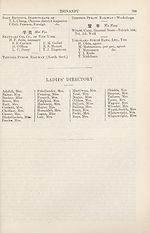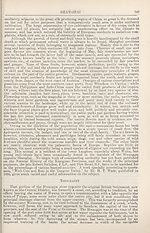1918
(780) [Page 706] - Shanghai
Download files
Complete book:
Individual page:
Thumbnail gallery: Grid view | List view
![(780) [Page 706] - Shanghai](https://deriv.nls.uk/dcn17/1949/0347/194903472.17.jpg)
SHANGHAI
}{p Shang-hai
Although situate nearly midway between Hongkong and Tientsin, Shanghai was
the most northerly of the Five Ports ” opened to foreign trade under the provisions
of the British Treaty of Nanking, and for many years constituted the northern limit
of the external trade of China. It lies in the alluvial peninsula formed between the
main mouth of the Yangtze River and Hangchow Bay, in the extreme south-east of
the province of Kiangsu, in latitude 31 ° 15' N. and longitude 121° 29' east of Green¬
wich, and at the junction of the Hwangpu River with the Woosung, the latter now
reduced to the dimensions of an ordinary tidal creek, and known to foreign residents
as the Soochow Creek. The Foreign Settlement is situated some twelve miles above
the junction of the Hwangpu with the most southern arm of the Yangtze. At this
junction is situated the town of Woosung, which some years ago the Chinese Govern¬
ment formally converted into a separate port open to foreign commerce. Except as a»
place of call for the large steaiiiers, which now carry on the rapidly.growing trans¬
pacific trade of Northern China, and as a convenient place of anchorage for the larger
craft while waiting for favourable tides or weather, this convenience is not much
availed of, owing mainly to the constricted and exposed nature of the anchorage-
ground available within the entrance of the Hwangpu. As a river the Hwangpu is of
comparatively recent origin, scarcely dating beyond the thirteenth century, before
which it was merely an unimportant canal. Lower Kiaugsu forms an immense plain,
the gift of the Yangtsze, and which is still growing at the rate of approximately two-
square miles per annum ; a few isolated hills, formerly constituting islands in the sear
alone rise from this plain, the nearest of which, the Fung-hwang-shan, consisting of
some six detached summits, none exceeding 250 feet in altitude, and distant from
fifteen to twenty miles, are visible from the higher buildings of Shanghai.
Flora and Fauna
This Kiangsu plain has been called the Garden of China, and the population is
perhaps denser than in any other portion of the Empire of equal extent. Estimates
vary, owing to the absence of any statistical sense in the Chinese as a people, but by
foreigners the population is usually accepted as from eight hundred to a thousand per
square mile. The soil, consisting entirely of alluvia carried down by the Yangtze,
is fairly fertile, and, the land being easily irrigated owing -to the numerous
waterways which traverse it in every direction, heavy crops of the various staples are
grown. Owing to the latitude and the fact that the rainfall is pretty well distributed
through the year, two crops per annum are regularly produced, and these are of
markedly different types ; the spring crop, gathered in May or June, being similar to-
that of the northern temperate regions elsewhere, while the autumn crop, gathered
in September and October, is distinctly tropical or sub-tropical. The spring crops
consist of wheat, two or three distinct varieties of barley, rape, and leguminous plants
i vaTUF Pescripti°ns, beans and lucerne predominating. The latter are frequently
ploughed into the land without gathering to make manure for the more valuable
summer products. The summer crops consist mainly of cotton and rice ; the cultiva-
Uon ot the former having of late years, owing to the growing demand for use at home,
and tor export to western and northern provinces, as well as to Japan,—where the-
cotton spinning and weaving industries have for several years past taken a firm hold—
considerably increased, accompanied by a similar decrease in the acreage under rice
cultivation. Ibis decrease is, however, to a certain extent counterbalanced by an
increase in the production of winter wheat, partly owing to an enlarged acreage, but
probably more to improved cultivation, stimulated by the introduction of steam flour-
imlls. Besides these staple crops there are grown during the summer peas and beans
ot several descriptions, oil bearing crops such as sesamum, and such domestic products
as cabbages,, carrots, melons, cucumbers, brinjals, etc. Although Shanghai is im-
}{p Shang-hai
Although situate nearly midway between Hongkong and Tientsin, Shanghai was
the most northerly of the Five Ports ” opened to foreign trade under the provisions
of the British Treaty of Nanking, and for many years constituted the northern limit
of the external trade of China. It lies in the alluvial peninsula formed between the
main mouth of the Yangtze River and Hangchow Bay, in the extreme south-east of
the province of Kiangsu, in latitude 31 ° 15' N. and longitude 121° 29' east of Green¬
wich, and at the junction of the Hwangpu River with the Woosung, the latter now
reduced to the dimensions of an ordinary tidal creek, and known to foreign residents
as the Soochow Creek. The Foreign Settlement is situated some twelve miles above
the junction of the Hwangpu with the most southern arm of the Yangtze. At this
junction is situated the town of Woosung, which some years ago the Chinese Govern¬
ment formally converted into a separate port open to foreign commerce. Except as a»
place of call for the large steaiiiers, which now carry on the rapidly.growing trans¬
pacific trade of Northern China, and as a convenient place of anchorage for the larger
craft while waiting for favourable tides or weather, this convenience is not much
availed of, owing mainly to the constricted and exposed nature of the anchorage-
ground available within the entrance of the Hwangpu. As a river the Hwangpu is of
comparatively recent origin, scarcely dating beyond the thirteenth century, before
which it was merely an unimportant canal. Lower Kiaugsu forms an immense plain,
the gift of the Yangtsze, and which is still growing at the rate of approximately two-
square miles per annum ; a few isolated hills, formerly constituting islands in the sear
alone rise from this plain, the nearest of which, the Fung-hwang-shan, consisting of
some six detached summits, none exceeding 250 feet in altitude, and distant from
fifteen to twenty miles, are visible from the higher buildings of Shanghai.
Flora and Fauna
This Kiangsu plain has been called the Garden of China, and the population is
perhaps denser than in any other portion of the Empire of equal extent. Estimates
vary, owing to the absence of any statistical sense in the Chinese as a people, but by
foreigners the population is usually accepted as from eight hundred to a thousand per
square mile. The soil, consisting entirely of alluvia carried down by the Yangtze,
is fairly fertile, and, the land being easily irrigated owing -to the numerous
waterways which traverse it in every direction, heavy crops of the various staples are
grown. Owing to the latitude and the fact that the rainfall is pretty well distributed
through the year, two crops per annum are regularly produced, and these are of
markedly different types ; the spring crop, gathered in May or June, being similar to-
that of the northern temperate regions elsewhere, while the autumn crop, gathered
in September and October, is distinctly tropical or sub-tropical. The spring crops
consist of wheat, two or three distinct varieties of barley, rape, and leguminous plants
i vaTUF Pescripti°ns, beans and lucerne predominating. The latter are frequently
ploughed into the land without gathering to make manure for the more valuable
summer products. The summer crops consist mainly of cotton and rice ; the cultiva-
Uon ot the former having of late years, owing to the growing demand for use at home,
and tor export to western and northern provinces, as well as to Japan,—where the-
cotton spinning and weaving industries have for several years past taken a firm hold—
considerably increased, accompanied by a similar decrease in the acreage under rice
cultivation. Ibis decrease is, however, to a certain extent counterbalanced by an
increase in the production of winter wheat, partly owing to an enlarged acreage, but
probably more to improved cultivation, stimulated by the introduction of steam flour-
imlls. Besides these staple crops there are grown during the summer peas and beans
ot several descriptions, oil bearing crops such as sesamum, and such domestic products
as cabbages,, carrots, melons, cucumbers, brinjals, etc. Although Shanghai is im-
Set display mode to:
![]() Universal Viewer |
Universal Viewer | ![]() Mirador |
Large image | Transcription
Mirador |
Large image | Transcription
Images and transcriptions on this page, including medium image downloads, may be used under the Creative Commons Attribution 4.0 International Licence unless otherwise stated. ![]()
| Asian directories and chronicles > 1918 > (780) [Page 706] - Shanghai |
|---|
| Permanent URL | https://digital.nls.uk/194903470 |
|---|
| Attribution and copyright: |
|
|---|---|
| Description | Volumes from the Asian 'Directory and Chronicle' series covering 1917-1941, but missing 1919 and 1923. Compiled annually from a multiplicity of local sources and research. They provide listings of each country's active corporations, foreign residents and government agencies of all nationalities for that year, together with their addresses. Content includes: various treaties; coverage of conflicts; currencies and taxes; consular fees; weights and measures; public holidays; festivals and traditions. A source of information for both Western states and communities of foreigners living in Asia. Published by Hongkong Daily Press. |
|---|---|
| Shelfmark | H3.86.1303 |
| Additional NLS resources: |

